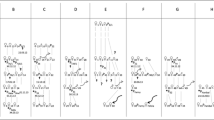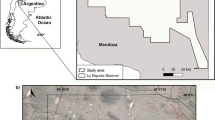Summary
Birds of paradise (Paradisaeidae) are a diverse, poorly known group of tropical forest passerines. The majority of species (34 of 43) are sexually dimorphic, known or presumed to be promiscuous, and known to exhibit a range of male spacing patterns, from territoriality to lek behavior. In this study we mapped male dispersion in nine species of birds of paradise at three sites in Papua New Guinea. We observed four patterns: 1) Dispersed (territorial): Black-billed Sicklebill (Epimachus albertisi), Brown Sicklebill (E. meyeri), and Superb Bird of Paradise (Lophorina superba); 2) Dispersed (non-territorial): Magnificent Riflebird (Ptiloris magnificus), Magnificent Bird of Paradise (Diphyllodes magnificus), and Twelve-wired Bird of Paradise (Seleucidis melanoleuca); 3) Exploded lek: King Bird of Paradise (Cicinnurus reguis)-most males paired, and Lawes' Six-wired Bird of Paradise (Parotia lawesii); and 4) True lek: Raggiana Bird of Paradise (Paradisaea raggiana). These findings revise earlier assessments of spacing in some species, and the example of C. regius is the first documentation of a paired-male distribution for birds of paradise. In Table 3 we categorize all species of promiscuous birds of paradise into these four classes of dispersion. Comparison of diet with dispersion revealed a significant relationship between the extent of frugivory and the breakdown of widely-spaced territorial behavior. Obligate insectivores defended exclusive territories, while highly frugivorous species formed leks. Species with intermediate diets showed patterns of dispersion intermediate between these two extremes. Resource defense appears to be a viable option for species whose diet contains less than approximately 50% fruit.
Similar content being viewed by others
References
Bechler B (1983a) The behavioral ecology of four birds of paradise. PhD dissertation, Princeton University, Princeton
Beehler B (1983b) Frugivory and polygamy in birds of paradise. Auk 100:1–12
Beehler B (1983c) Notes on the behaviour and ecology of MacGregor's Bird of Paradise. Emu 83:28–30
Borgia G (1979) Sexual selection and evolution of mating systems. In: Blum MS, Blum NA (eds) Sexual selection and reproductive competition in insects. Academic Press, New York, pp 19–80
Bradbury JW (1981) The evolution of leks. In: Alexander RD, Tinkle D (eds) Natural selection and social behavior. Chiron press, New York, pp 138–169
Brown JL (1975) The evolution of behavior. Norton Press, New York
Brown JL, Orians GH (1970) Spacing patterns in mobile animals. Annu Rev Ecol Syst 1:239–262
Cooper WT, Forshaw JM (1977) The birds of paradise and bowerbirds. Collins Press, Sydney
Crook JH (1964) The evolution of social organization and visual communication in weaverbirds (Ploceinae). Behaviour (Suppl) 10:1–178
Diamond JM (1972) Avifauna of the eastern highlands of New Guinea. Publ Nuttall Ornith Club 12, Cambridge, MA
Emlen SG, Oring LW (1977) Ecology, sexual selection, and the evolution of mating systems. Science 197:215–223
Foster MS (1977) Odd couples in manakins: a study in social organization and cooperative breeding in Chiroxiphia linearis. Am Nat 111:845–853
Gilliard ET (1969) Birds of paradise and bower birds. Weidenfeld and Nicolson, London
Gullion GW (1976) Reevaluation of “activity clustering” by male grouse. Auk 93:192–193
Hjorth I (1970) Reproductive behavior in Tetraonidae. Viltrevy 7:183–596
LeCroy M (1981) The genus Paradisaea: displays and evolution. Am Mus Nat Hist Novit 2714:1–52
LeCroy M, Kulupi A, Peckover WS (1980) Goldie's Bird of Paradise: display, natural history and traditional relationships of the people to the bird. Wilson Bull 92:289–301
Lill A (1976) Lek behavior in the Golden-headed Manakin Pipra erythrocephala in Trinidad (West Indies). Fortschr Verhaltensforsch 18:1–84
Myers JP (1979) Leks, sex and buff-breasted sandpipers. Am Birds 33:823–825
Orians GH (1961) The ecology of blackbird (Agelaius) social systems. Ecol Monogr 31:285–312
Orians GH (1969) On the evolution of mating systems in birds and mammals. Am Nat 103:589–603
Oring LW (1982) Avian mating systems. In: Farner DS, King JR (eds) Avian biology, vol 6. Academic Press, New York, pp 1–92
Payne R, Payne K (1977) Social organization and mating suecess in local song populations of village indigo birds Vidua chalybeata. Zeit Tier 45:113–173
Pitelka FA (1959) Numbers, breeding schedule, and territoriality in pectoral sandpipers of northern Alaska. Condor 61:233–262
Pitelka FA, Holmes RT, MacLean SF (1974) Ecology and evolution of social organization in arctic sandpipers. Am Zool 14:185–204
Pruett-Jones MA, Pruett-Jones SG (1982) Spacing and distribution of bowers in MacGregor's Bowerbird. Behav Ecol Sociobiol 11:25–32
Schodde R (1976) Evolution of the birds-of-paradise and bowerbirds: a resynthesis. In: Frith HJ, Calaby JH (eds) Proc Int Ornith Congr No 16. Austr Acad Sci, Canberra
Scott JW (1942) Mating behavior of the Sage Crouse. Auk 59:477–498
Snow BK (1974) Lek behavior and breeding of Guy's hermit hummingbird Phaethornis guy. Ibis 116:278–297
Snow DW (1976) The web of adaptation. Quadrangle Press, New York
Warner RR (1980) The coevolution of behavioral and life history characteristics. In: Barlow GW, Silverberg J (eds) Sociobiology: beyond nature/nurture? Westview Press, Boulder, pp 151–188
Wiley RH (1974) Evolution of social organization and life-history patterns among grouse. Q Rev Biol 49:210–227
Wittenberger JF (1978) The evolution of mating systems in grouse. Condor 80:126–137
Wittenberger JF (1979) The evolution of mating systems in birds and mammals. In: Marler P, Vandenburgh JG (eds) Handbook of behavioral neurobiology. Plenum Press, New York, pp 271–349
Author information
Authors and Affiliations
Rights and permissions
About this article
Cite this article
Beehler, B., Pruett-Jones, S.G. Display dispersion and diet of birds of paradise: a comparison of nine species. Behav Ecol Sociobiol 13, 229–238 (1983). https://doi.org/10.1007/BF00299927
Received:
Accepted:
Issue Date:
DOI: https://doi.org/10.1007/BF00299927




